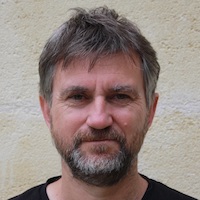-
Share this page
Frédéric Castet
Professor, Institut des Sciences Moléculaires, Bordeaux
 Frédéric Castet completed a Ph.D. in Theoretical Chemistry in 1999 at the University of Bordeaux, the subject of which was the elaboration of a correlated fragment orbital method to describe charge transfer processes in organic superconductors. He then accomplished a post-doctoral stay at the University of Namur (Belgium), where he worked on the evaluation of second order optical susceptibilities of molecular assemblies and crystals. In 2000, Frédéric was recruited as Maître de Conférences (Assistant Professor) in the chemistry department of the University of Bordeaux. He obtained the accreditation to supervise researches in 2009, and was appointed Full Professor in 2014.
Frédéric Castet completed a Ph.D. in Theoretical Chemistry in 1999 at the University of Bordeaux, the subject of which was the elaboration of a correlated fragment orbital method to describe charge transfer processes in organic superconductors. He then accomplished a post-doctoral stay at the University of Namur (Belgium), where he worked on the evaluation of second order optical susceptibilities of molecular assemblies and crystals. In 2000, Frédéric was recruited as Maître de Conférences (Assistant Professor) in the chemistry department of the University of Bordeaux. He obtained the accreditation to supervise researches in 2009, and was appointed Full Professor in 2014.
His research activities consist in the use of theoretical chemistry methods to determine the structural, electronic, and optical properties of organic conjugated compounds with promising characteristics for exploitation in electronics, optoelectronics or photonic devices. His recent works focussed on the simulation of electron transfer mechanisms in organic semiconductors and at their interfaces, as well as on the modeling of the nonlinear optical properties of molecular systems and materials.
Institut des Sciences Moléculaires (ISM, UMR CNRS 5255), Université de Bordeaux, 351 Cours de la Libération, 33405 Talence, France.
frederic.castet@u-bordeaux.fr
Keynote: Dynamic effects in calculations of second-order NLO properties of organic molecules in complex environments
The last thirty years have witnessed an ever-growing application of computational chemistry for rationalizing the nonlinear optical (NLO) responses of organic chromophores. More specifically, quantum chemical calculations proved highly helpful in gaining fundamental insights on the factors governing the magnitude and character of molecular first hyperpolarizabilities, be they either intrinsic to the chromophore molecular structure and arising from symmetry, chemical substitution or π-electron delocalization, or induced by external contributions such as the laser probe or solvation and polarization effects. However, most theoretical studies rely on the assumption that the investigated systems are rigid in nature, the NLO responses being computed solely at the most stable geometries of the chromophores. Although this choice is usually well-grounded for obtaining a qualitative description of the NLO properties, our recent studies combining classical molecular dynamics (MD) simulations and DFT calculations, backed up by experimental observations, have evidenced the significant role of structural fluctuations.
In this talk, we present recent case studies in which theoretical simulations have highlighted these effects. The presentation specifically focuses on the simulation of the second-order NLO properties that can be measured experimentally either from Hyper-Rayleigh Scattering (HRS) or Electric-Field Induced Second Harmonic Generation (EFISHG). Selected examples include i) dye/iodide ionic complexes in the liquid phase, in which the position of the iodide relative to the cationic chromophore is at the origin of the magnitude of the second- and third-order contributions of the EFISHG signal, ii) self-assembled monolayers based on molecular photoswitches, in which geometrical distortions, orientational and positional disorder of the molecules within the SAMs highly impact their NLO response and contrast upon switching, and iii) nanoparticles formed by organic dipolar dyes in water solution, whose soft nature allows for large shape variations, also translating into huge fluctuations in time of their NLO responses.
